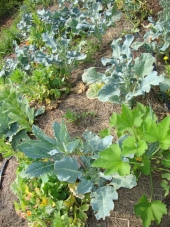
 1
1




Pamela Melcher
Happiness, Health, Peace and Abundance for All.
 2
2




find religion! church
kiva! hyvä! iloinen! pikkumaatila
get stung! beehives
be hospitable! host-a-hive
be antisocial! facespace




Pamela Melcher
Happiness, Health, Peace and Abundance for All.





find religion! church
kiva! hyvä! iloinen! pikkumaatila
get stung! beehives
be hospitable! host-a-hive
be antisocial! facespace




Pamela Melcher
Happiness, Health, Peace and Abundance for All.




Pamela Melcher
Happiness, Health, Peace and Abundance for All.













Pamela Melcher
Happiness, Health, Peace and Abundance for All.




John Polk wrote:I know that buckwheat is a great potash (K) accumulator, but I never heard it was good for phosphorus (P) also.
I believe most clovers are better P scavengers than buckwheat.
Buckwheat is known as
a “phosphorus pump” because it is assumed the roots
solubilize phosphorus from phosphate precipitates in
the soil profile and subsoil. The following characteristics make it outstanding for its phosphorus efficiency:
1) a finely divided root system with a high ratio of root
surface to root or shoot length; 2) a high storage capacity for inorganic phosphorus; 3) an increased release of
protons and solubilizing substances by phosphorusdeficient plants; 4) a favorable ratio of phosphorus
uptake to root mass growth, especially at a low phosphorus supply; 5) a high activity of acid phosphatase in
the rhizosphere and the capability to use phosphorus
from organic sources (Gardner and Boundy, 1983).
Buckwheat has poor response to nitrogen fertilizer due
to its short growing season (“Crops of Other Plant
Families”). It has a higher tolerance to soil acidity than
any other grain crop (“Alternative Field Crops
Manual,” 1989).




Brenda
Bloom where you are planted.
http://restfultrailsfoodforestgarden.blogspot.com/




Pamela Melcher wrote:Thanks, Til. Jacke (see above ) says, so far, plants which like acid soil and have tap roots: Columbine ( sun to shade); Cow parsnip; Sea beet (a perennial veg - I am looking for these - anyone know a good source?); Chicory. To be continued.
Permaculture: The Edge is the New Center
Taos, New Mexico / Carson, New Mexico / 7000ft / zones 5,6 / Soil: Servilleta-Hernandez / Avg. 13" precip per annum




Pamela Melcher
Happiness, Health, Peace and Abundance for All.




Pamela Melcher wrote:
It looks, from when I transplant blueberries, like they have very shallow fibrous roots, so I do not want to potentially crowd them with the shallow peppermint roots.
Permaculture: The Edge is the New Center
Taos, New Mexico / Carson, New Mexico / 7000ft / zones 5,6 / Soil: Servilleta-Hernandez / Avg. 13" precip per annum




Pamela Melcher
Happiness, Health, Peace and Abundance for All.




Pamela Melcher
Happiness, Health, Peace and Abundance for All.




Brenda Groth wrote:i started the original thread..yesterday I put out some seeds in my blueberries..behind them up the lattice I put rattlesnake beans, and in front I put soybeans, between I put seeds of sunflowers and also a few zucchini seeds..we'll see how those go for this year until I can get some permanent plants in there..I also have a no bog cranberry groundcover coming.




George Lee wrote:
I interplant japanese buckwheat with my blueberry bushes to keep a population of beneficial insects around...
There are times I see hoppers or caterpillars on my young blueberry plants, the ones with ripe light green growth...
If I can keep insectiary wasps around, they'll often sting the perpetrators...
Not only that, but buckwheat is one of the best phosphorous accumulators out there and fruit bearers need it especially.
Cheers -

|
Tongue wrestling. It's not what you think. And here, take this tiny ad. You'll need it.
Learn Permaculture through a little hard work
https://wheaton-labs.com/bootcamp
|




